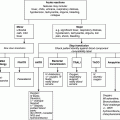Chapter 30 Arvind Arumainathan1 and Daniel Collins2 1 Department of Haematology, Royal Liverpool University Hospital, Liverpool, UK 2 Department of Pharmacy, Royal Liverpool University Hospital, Liverpool, UK The majority of patients with haematological malignancy who need intensive care unit (ICU) admission do so because of treatment-related complications. However, on occasion, newly diagnosed patients require organ support. Causes of ICU admission at initial presentation and their usual sequelae may include: In these situations, intensive supportive care alone is generally insufficient, and definitive treatment in the form of chemotherapy may need to be initiated on the ICU. Patients with haematological malignancies (acute leukaemia or lymphoma) comprise the majority of cancer patients requiring chemotherapy on the intensive care at their initial presentation [1]. Chemotherapy may be given with curative intent or for disease control. In the latter case, many patients will achieve remission for several years or more with treatment. Expert consensus opinion recommends that newly diagnosed patients should have full access to ICU and that for patients suitable for ICU requiring chemotherapy, this should be delivered, along with life-sustaining therapies, until that chemotherapy becomes effective [1]. In a retrospective study of 37 patients with haematological malignancy requiring intravenous chemotherapy in ICU, in-hospital mortality was 43% and 6-month mortality 67%. Hospital mortality was not predicted by whether chemotherapy was given at diagnosis or relapse [2]. In a prospective study of 100 cancer patients requiring chemotherapy in ICU at diagnosis, hospital mortality was 41% and 6-month mortality was 51% [3]. Broadly, traditional cytotoxic chemotherapy interferes with cell division and replication. These effects are usually not specific to the malignant cells and are thus responsible for some of the generic side effects of chemotherapy, such as bone marrow suppression and gut irritation. Newer approaches include the use of monoclonal antibodies and targeted molecular therapies, which tend to lack these generic complications, but can still cause significant problems in the acutely ill patient, for example, infusion-related reactions. Understandably, few data to guide best practice in this area exist. The decision to initiate chemotherapy on the ICU must thus be made after a careful assessment of the risks and benefits to the patient and close discussion between the haematology and intensive care teams [4]. Families – and patients where possible – must also be closely involved and made aware of the associated risks. Chemotherapy can be teratogenic and may also reduce fertility in the longer term. The possibility of pregnancy must be considered and issues of fertility sensitively explored. Issues of consent are discussed in Chapter 26. Staff familiar with cytotoxics must perform chemotherapy administration, and close pharmacy support is mandatory [5]. Steroids alone can have a significant effect on treatment naïve, highly proliferative haematological malignancies. Some critically ill patients will not be diagnosed until after their ICU admission. Consider the need to obtain diagnostic samples and tumour lysis prophylaxis in patients with a suspected haematological malignancy before prescribing steroids. For example, the 200–300 mg hydrocortisone per day (equivalent to approximately 50–60 mg prednisolone) for 5–7 days suggested by the surviving sepsis campaign for vasopressor and fluid refractory hypotension would be a therapeutic dose for some high-grade lymphomas, although without consolidation with combination chemotherapy, any response would not be sustained. After the patient is stabilized, consideration must be given to the specific interventions that may be possible for the underlying disorder. For example, in ventilatory failure caused by leukostasis, therapeutic leukapheresis may also be required. Discussions about initiating chemotherapy must also take place between the intensive care and haematology teams. If initiating chemotherapy, this should take place as soon as is feasible and safe. The haematology team should ensure that the intensive care team is aware of the regimen and drugs used, common and significant complications of these drugs and procedures for safe handling. Specialist cytotoxic and intensive care pharmacists play a valuable role and must be closely involved in discussion at all stages. These situations are dynamic, and clear communication, ideally at consultant level, must take place regularly, particularly in respect to patients’ prognosis in light of their clinical progress. An important practical aspect of chemotherapy administration is good venous access. Patients in the ICU are likely to have central venous access, which is also useful for concomitant administration of supportive measures such as hydration and antimicrobials. In patients likely to need medium- to longer-term access (such as patients with acute leukaemia), consideration should be given to early insertion of a tunnelled catheter. Central venous access is not always necessary as some chemotherapy agents can be given peripherally. Admission to the ICU, coupled with a new diagnosis of cancer, is an incredibly difficult time for patients and families. Communication, respect and compassion have been demonstrated to be as important as good medical care in improving family satisfaction on the ICU [6]. The support of trained counsellors and psychologists may be useful. The initial chemotherapy regimen may be tailored to minimize toxicity, depending on the degree of physiological disturbance and organ dysfunction. Care must be taken to avoid drug interactions, especially in patients receiving antimicrobial therapy. For example, plasma methotrexate levels are increased in patients receiving co-trimoxazole or trimethoprim and itraconazole potentiates the neuromuscular side effects of vincristine. Prescribing of chemotherapy should follow an agreed treatment protocol [7, 8]. Most agreed protocols contain information for prescribers on dose modification of chemotherapy for impaired organ function, such as in renal or hepatic impairment. It is crucial that prescribers refer to these protocols when initiating chemotherapy for patients on ICU. Specialist haemato-oncology pharmacists can play a crucial role in the verification of dose attenuations and may sometimes refer to alternative resources for further clarification [9]. Examples of chemotherapy that may require attenuation include: Table 30.1 later presents the agents used most commonly in haemato-oncology practice and some of their major side effects. Immunosuppression would also be expected with the majority of cytotoxic drugs but will vary with class and dose. Table 30.1 Cytotoxic agents commonly used in haemato-oncology and associated common or major side effects (abbreviations in the succeeding text).
Delivering Chemotherapy on Intensive Care
Introduction
Approach to the patient
Multidisciplinary discussion
Venous access
Psychosocial support
Chemotherapy administration
Chemotherapy selection and dose attenuation
Class
Drugs
Nausea/vomiting
Mucositis
Dose in renal impairment
Dose in hepatic impairment
Class-specific effects
Drug-specific side effects
Alkylating agents
Bendamustine
Mild
Uncommon
Clinical decision in severe impairment
Dose reduce if Bil > 20 µmol/L
Bleomycin
Mild
High doses
Dose reduce if CrCl < 50 mL/min
Clinical decision in severe impairment
Pneumonitis
Carmustine
Moderate
High doses
Dose reduce if CrCl < 60 mL/min
Clinical decision in severe impairment
Cyclophosphamide
Moderate
High doses
Dose reduce if CrCl < 20 mL/min
Clinical decision in severe impairment
Haemorrhagic cystitis
Ifosfamide
Severe
Uncommon
Dose reduce if CrCl < 60 mL/min
Clinical decision in severe impairment
Haemorrhagic cystitis, encephalopathy
Melphalan
Moderate
High doses
Dose reduce if CrCl < 50 mL/min
No dose reduction necessary
Purine analogues
Cladribine
Mild
Uncommon
Clinical decision in severe impairment
Clinical decision in severe impairment
T-cell dysfunction
Fludarabine
Mild
Uncommon
Dose reduce if CrCl < 70 mL/min
No dose reduction necessary
T-cell dysfunction
Nelarabine
Moderate
Stomatitis
Clinical decision in severe impairment
![]()
Stay updated, free articles. Join our Telegram channel

Full access? Get Clinical Tree

 Get Clinical Tree app for offline access
Get Clinical Tree app for offline access




